Data summary report - November 2018
Compared to other tag and release databases that exist for skate in Scotland, Skatespotter is relatively new and only contains records for a handful of years so far (2011 – present day). However, we feel we have proved that photo ID is a valid tool for monitoring skate. We plan to continue collecting photos to monitor skate numbers within the Loch Sunart to the Sound of Jura MPA and we hope to expand the database to include other areas of Scotland.
So far, we have included 1536 photos of 791 individual skate in the Skatespotter database, dating back to 2011. Out of these, 340 fish have been recaptured at least once (43%). Overall our volunteer skippers have caught significantly more females (530, or 67% of total) than males (258, or 33% of total). Of these, 111 (43%) males and 229 (43%) females have been recaptured at least once. The gender of three additional skates has not yet been determined from available photos.
Firth of Lorn
In the Firth of Lorn, where most of the catch effort has been concentrated to date, 600 individual fish have been captured and photographed, of which 48% have been recaptured at least once. In the Firth of Lorn, we’ve identified 206 (34%) males and 391 (65%) females, with 101 (49%) males and 185 (47%) females being recaptured at least once.
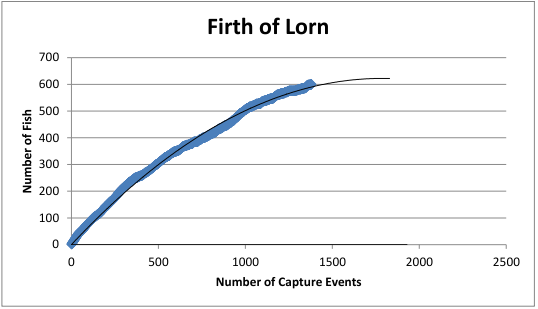
This is a discovery curve which can be used to estimate the approximate number of animals within a population. It plots the number of capture events over time against the number of new skate captured. As the number of capture events increases over time, the curve will level out as you get more recaptures and stop identifying new fish. If you have enough data, you can extrapolate the curve forwards to see where it may level out – which provides an estimated maximum number of fish in the area. As you can see in our discovery curve for the Firth of Lorn, the curve is beginning to level out. This suggests that there may be just over 600 skate in the area, so there probably aren’t many more new ones to be found! It isn’t that simple of course! The situation is complicated by the fact that we are likely to have some resident skate and some more transient skate which pass through the area (and we aren’t sure of the ratio of residents to transients), so we do expect to capture new fish as we continue monitoring the MPA and our estimate of population by this method may change. We intend to also use the data to more accurately estimate the population size using advanced modelling techniques, now that we have 3 years of photo ID data. This involves entering the various capture and recapture events of all the skate in our database into a computer programme. The programme allows you to estimate the number of skate in the site, based on various assumptions about factors affecting their survival rates from one year to the next (such as amount of food present, natural life expectancy, rates of migration etc.). It can also allow you to see what might happen to the population if any of those factors were to change. It will be interesting to compare the results of the 2 methods.
Sound of Jura
In the Sound of Jura, our volunteer skippers have submitted photos of 191 skate so far with 29% of skate being recaptured at least once. The recapture rate in the Sound of Jura is currently lower than the Firth of Lorn because we haven’t got as many useable photos dating back as far - we expect the recapture rate for this site will catch up to the Firth of Lorn at some point! Fifty two male fish have been identified but only 10 of these have been recaptured at least once as of November 2018 (19% of total). Of the 139 females in the Sound of Jura, 44 or 31% have been recaptured at least once so far.
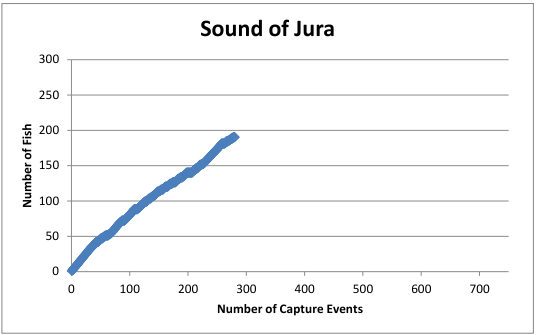
This is the discovery curve for the Sound of Jura so far, it is estimating the number of skate at this site to be around 270. This seems quite low since the deep water habitat preferred by skate spreads from Crinan to Northern Ireland and skate tagged in previous tagging studies at Crinan have been recaptured in Northern Ireland. The low estimate could be because we don’t have enough data yet or because the photos we have received for the Sound of Jura are only from a small area in the north of the site.
Recaptures
The skate differ in their captures rates, with some fish only caught once whilst others have been encountered several times suggesting some skate stick around in the MPA (residents) while others range more widely, leaving the site and returning occasionally (transients). So far, our most frequently recorded fish is Di000122, a 72.5kg (160lb) female from the Firth of Lorn. She was first photographed in October 2015 and has since been caught a further 14 times - most recently on the 15th of September 2018! The prize for most frequently recorded male goes to skate Di000289. So far, he’s been caught a total of 12 times, between March 2016 and August 2018. Skate Di000289 is fairly small, weighing in at 26kg (58lb) and, like several other fish in the database, he is missing the end of his tail. In total we have 11 skate in the database (1.4%) with some sort of scarring (damaged tail, cheek scars) that we believe occurred as result of being captured by accident by mobile gear vessels (bycatch) and being poorly handled before or during release. Perhaps the most noteworthy of these is Di000063, a large female with a broken rostrum (or nose) and cheek scars who has been recorded 5 times between the 24th May 2015 and the 5th May 2017.
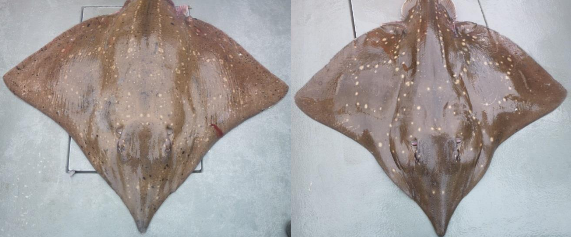
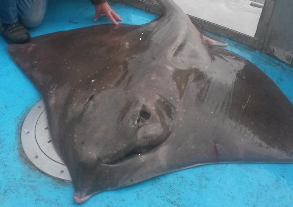
Even though we have a high recapture rate, lots of time can pass between recaptures. For example, we first photographed Di000010 on the 1st of April 2012. She wasn’t caught again until 1124 days, or 3 years and 9 days, later, on the 30th of April 2015. Likewise, skate Di000006 had 1098 days, or 3 years and 3 days, between her first and second photos. Occasionally, but rarely, a fish will get caught twice on the same day, like skates Di000246, Di000315 and Di000469. In the case of Di000315 and Di000469, the skate were caught twice on the same day by the same skipper on the same fishing mark only a few minutes apart (2 hours and 22 minutes and 3 hours and 40 minutes, respectively) both on the 26th of March 2018! Skate Di000246 was captured by different skippers on the same day, at 11:07 and 14:46 on the 20th of April 2017 on 2 different fishing marks almost 700m apart off Kerrera. Some fish have been caught a few times but with weirdly evenly spaced recaptures. For example, Di000015 has been caught on three occasions, always 2 years apart in 2013, 2015 and 2017. Maybe we will see her again in 2019?
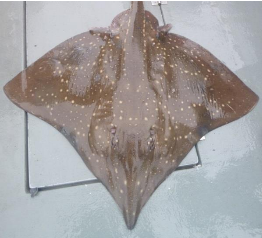
Big skate!
The common skate is the largest skate species in Europe, so it is no surprise that we have some massive skate in our database. As most of you know, female skate grow much larger than males and our biggest 3 fish are all females. Di000206 is the largest one so far, estimated at 100kg (222lb) from her length and width on the 2nd of May 2018! She was previously estimated as 99kg (219lb) when she was captured just under a year earlier on the 14th of May 2017. Close behind are Di000396 and Di000098, both at 99kg (219lb). Not only are these gargantuan fish over 2.2m (89 inches) long, they are both over 1.75m (69 inches) wide. That’s the same as the average Scottish man is tall! Di000396 has been measured 6 times in total, with her recorded weight fluctuating from 98 kg (216lb) to 99kg (219lb). Meanwhile, Di000098 was first measured on the 17th of March 2016 weighing 98kg (216lb). When she was recaptured 2 years later, she was 99kg (219lb). The two largest males so far are Di000221 and Di000744, at 63kg (138lb) and (62kg) 136lb respectively. As most of you know, the values for weight are estimated by comparing the length and width to tables with known values for skate. Just a reminder to be as accurate as possible when recording widths, lengths and weights!
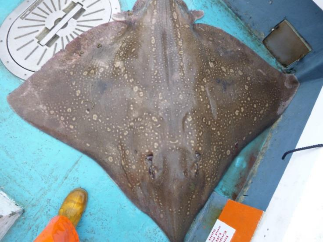
Skate movements
To date, all our skate are from the Firth of Lorn or Sound of Jura. Even though these areas are close to each other (see the map below), so far, only two of the fish in our database have definitely made the journey between the two areas. Di000424 was first caught in the Sound of Jura on the 2 nd of September 2017. She was then recaptured 335 days later on the 3 rd of August 2018 in the Firth of Lorn, over 40km away as the crow flies! In reality, she would probably have swum an even greater distance, likely navigating through the deep channels between the 2 sites. Di000228 has also travelled between the two areas. He was originally caught in the Firth of Lorn on the 14th March 2016. Just over a month later on the 29th of April, he was recaught – this time in the Sound on Jura! He has since been caught another 5 times, most recently the 27th of October 2017, and all in the Firth of Lorn.
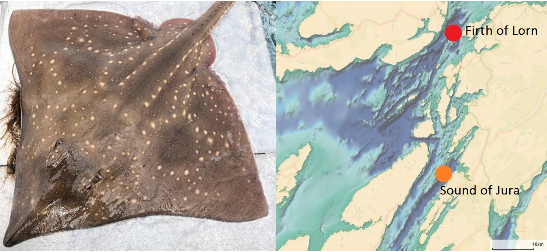
Skate image gallery
We are continually working on the catalogue and hope to update it every 3 months or so. Please check back often to see if your photo has been added.




